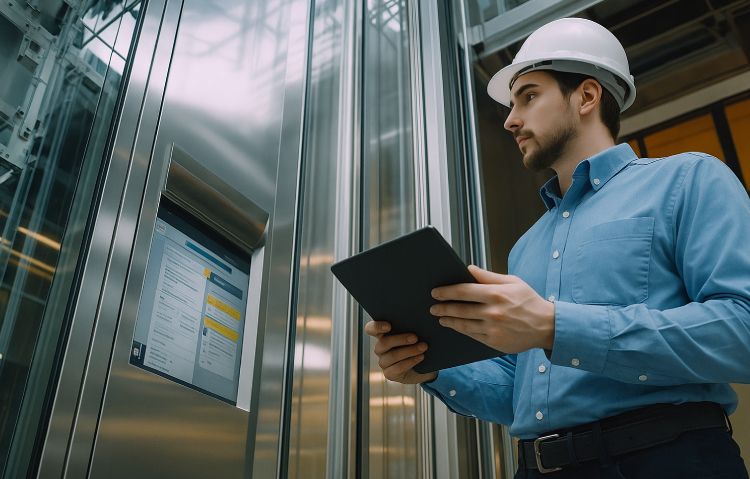Services
ELEVATOR ADA REQUIREMENTS


Whether you are a business owner, architect, or project manager, we are here to assist you. Elevate your inquiry by filling out the form below. Provide us with some initial details about your project, and we'll get back to you promptly with a customized elevator solution.
Elevator ADA requirements exist to ensure that people with disabilities can use elevators safely and without assistance. With nearly 1 in 4 U.S. adults living with a disability, according to the CDC, the need for accessible design has never been more clear. Under the Americans with Disabilities Act (ADA), these rules cover everything from button placement to door timing—removing barriers and creating spaces everyone can navigate.
What Makes an Elevator ADA-Compliant?
To meet ADA guidelines, elevators must align with the 2010 ADA Standards for Accessible Design. These rules apply to commercial, public, and multi-tenant residential buildings.
Key requirements include
- Cab dimensions that accommodate wheelchairs
- Control panels within reach and readable by touch
- Audible tones and voice announcements for each floor
- Visual indicators and Braille markings
- Smooth door operation and timing
- Appropriately placed handrails
These design requirements directly support individuals with physical challenges. In fact, mobility-related disabilities affect about 14% of U.S. adults, making accessible elevator design a crucial part of any building plan. Failing to comply can lead to fines, legal claims, delays in occupancy approval—and damage to your building’s reputation.


Why ADA-Compliant Elevators Matter
Beyond legality, accessible elevators promote independence, dignity, and ease of use for all individuals—especially:
- People with mobility impairments
- Seniors
- Parents with strollers
- Visitors with temporary injuries
As all Baby Boomers reach age 65 or older by 2030, the demand for accessible buildings is expected to grow significantly over the next few years.
The Risks of Non-Compliance
- Fines and lawsuits from disability rights violations
- Delays in receiving certificates of occupancy
- Denial of grants or funding from government agencies
- Insurance complications due to regulatory lapses
Failure to comply with ADA standards can also be expensive—fines may reach up to $75,000 for a first violation and $150,000 for additional offenses, according to the Department of Justice. Accessible elevators aren’t just a feature—they’re a responsibility.
Core Features of an ADA-Compliant Elevator
Cab Dimensions & Interior Space
To accommodate users with wheelchairs or walkers, cabs must meet specific clearances:
- Center-opening doors: 51" depth × 80" width
- Side-opening doors: 51" depth × 68" width
- Flooring: Slip-resistant and easy to maneuver on
Control Panel Design
Controls should be usable by all, including those seated or with visual impairments:
- Located 15–48 inches from the floor
- Tactile buttons with Braille and raised lettering
- Backlit indicators for easy reading
- Optional voice-activated features for added accessibility
Door Operation Standards
Doors must function with accessibility in mind:
- Openings of at least 36 inches
- A minimum 5-second delay before closing
- Infrared sensors to detect people or mobility devices
Visual and Audible Signals
Every ADA-compliant elevator must include:
- Audible chimes and verbal floor announcements
- Visual indicators showing floor levels and direction
- Emergency signals visible and audible to all users
New Construction vs. Existing Buildings
For New Buildings
New public and commercial construction must include:
- Fully ADA-compliant elevators
- Access to every public floor
- Accessible emergency communication systems
For Existing Structures
Older buildings must make “readily achievable” improvements, which can include:
- Retrofitting door sensors
- Lowering control panels
- Adding visual and audible signals
- Installing signage and intercom upgrades
Keeping Elevators ADA-Compliant Over Time
Routine Inspections Should Include:
- Operational door reversal sensors
- Functional emergency intercom systems
- Clear floor announcements
- Well-maintained Braille and tactile buttons
- Adequate interior lighting per standards
When Modernization is Needed
If your elevator is outdated or doesn’t meet current ADA standards, upgrades can include:
- Control panel replacements
- Interior redesign for space and functionality
- Voice announcement systems
- Upgraded signage and lighting
These updates not only meet legal standards but also improve safety and ease of use for everyone.
Additional ADA Considerations
Emergency Communication Features
- Must include two-way systems accessible without speaking
- Controls must be placed no higher than 48 inches
- Systems must provide visual confirmation for hearing-impaired users
Signage and Wayfinding
- Use tactile and Braille signage
- Include high-contrast lettering and symbols
- Ensure signage is placed in consistent, easy-to-find locations
Clear wayfinding ensures every visitor—regardless of ability—can navigate your building confidently.
Achieving Full ADA Compliance
Step 1: Work with an Accessibility Consultant
Professionals can:
- Evaluate existing elevators
- Pinpoint compliance gaps
- Recommend practical, cost-conscious solutions
Step 2: Partner with Skilled Elevator Contractors
Experienced installers understand:
- ADA specifications
- Local and national code overlaps
- How to deliver upgrades without disrupting operations
The Benefits of ADA-Compliant Elevators
Going beyond compliance creates real-world value. Accessible buildings are more attractive to a wider range of tenants, clients, and visitors.
Increased Property Value and Market Appeal
ADA-compliant elevators make your building more attractive to buyers, tenants, and investors. Accessibility features show long-term planning and inclusive design, which can boost your property's overall value. Compliance also opens your space to a broader market, including government and corporate clients who prioritize accessible buildings when choosing locations or awarding contracts.
Better Tenant Satisfaction
When your elevators are ADA-compliant, every resident, employee, or guest—regardless of ability—can move around safely and independently. That level of consideration leads to better experiences and higher tenant satisfaction. Accessible features reduce complaints, foster a sense of inclusivity, and help create a building environment where everyone feels welcome, valued, and accommodated.
Stronger Brand Reputation
Buildings that prioritize accessibility stand out in a positive way. By installing ADA-compliant elevators, you signal that your company or property management team cares about inclusion, safety, and quality. This attention to detail can enhance your brand image, build trust with clients, and attract partners or tenants who value socially responsible design.
Fewer Legal and Insurance Issues
Compliance with ADA standards helps protect your building from lawsuits, fines, or denied occupancy permits. It also improves your standing with insurers and may even reduce premiums. Investing in accessible elevator systems is a smart, proactive way to avoid legal headaches and keep your operations smooth, secure, and financially protected over time.
Our Consulting Approach: Simple, Structured, Supportive
At Mountain Cross Consulting, we make ADA compliance straightforward with a hands-on process:
Full System Assessment
Our process starts with a comprehensive look at your existing elevator setup. We examine everything—cab dimensions, control placement, signage, and more—to identify areas where your system may fall short. This deep dive allows us to build a clear plan for improvements that boost safety, increase accessibility, and keep your building compliant and future-ready.
Personalized Upgrade Plan
After we’ve reviewed your elevator systems, we put together a plan that’s built around your specific needs and budget. Whether it’s a few targeted upgrades or a complete overhaul, we focus on changes that make a real difference. Our recommendations are straightforward and cost-effective, helping you meet ADA standards without overspending or disrupting daily operations.
On-Site Support
We don’t just give you a plan and walk away. Our team stays actively involved during implementation, coordinating with contractors, vendors, and building staff to keep everything on track. From timelines to quality control, we ensure the process is seamless—delivering the results you need while minimizing downtime and keeping your operations running smoothly.
Long-Term Maintenance
Compliance isn’t a one-and-done deal. We offer ongoing support to keep your elevators safe, reliable, and ADA-compliant. Our maintenance plans include regular inspections, updates on code changes, and proactive service checks. With Mountain Cross Consulting by your side, you can avoid surprises—and ensure your systems perform consistently, year after year.
FAQs About Elevator ADA Compliance
What are the minimum ADA elevator requirements?
To meet ADA standards, elevators must include tactile buttons with Braille, audible signals that announce each floor, proper door width and timing, and communication systems usable by people with visual, hearing, or mobility impairments. These features are essential to ensure independent, safe use for all riders—especially those with disabilities—and they help property owners avoid legal issues and improve accessibility throughout the building.
What size does an ADA-compliant elevator cab need to be?
ADA-compliant elevator cabs must offer enough space for wheelchair users to comfortably enter, turn, and exit. For side-opening doors, the interior should be at least 51 inches deep by 68 inches wide. For center-opening doors, the width increases to 80 inches. These measurements are designed to support safe maneuvering, especially for people using mobility aids or other assistive devices.
Is Braille mandatory on all elevator buttons?
Yes, Braille and raised tactile markings are required on every elevator button under ADA rules. These markings help people who are blind or have low vision find and use controls like floor numbers and emergency buttons without assistance. The Braille must be placed on or right beside the button, making elevator navigation more accessible and independent.
What’s required for emergency communication?
ADA-compliant elevators must have a two-way emergency communication system that works for everyone, including those who can’t speak or hear. The system should be usable from a seated position, require minimal hand movement, and offer visual confirmation that help is on the way. This ensures individuals with disabilities can request assistance safely during emergencies without relying on verbal communication.
Ready to Make Your Elevators ADA-Compliant?
Don’t wait for a failed inspection or costly lawsuit to force action. At Mountain Cross Consulting, we make ADA compliance simple, strategic, and tailored to your building’s needs. Whether you’re upgrading an old system or designing new construction, we’re here to help you get it right—efficiently, affordably, and with expert support every step of the way.
Let’s make your building accessible to everyone.
📞 Call us at (224) 500‑0321

